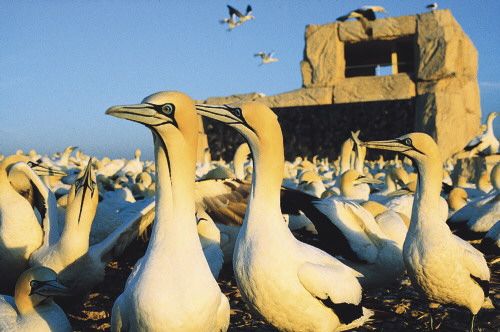Bird Island is approximately three hectares in size but is one of the most interactive of nature reserves. Birds, seals and the fishing boats of Lambert’s Bay all come and go. The breakwater that connects the island to the mainland and that creates the Lambert’s Bay harbour was built in 1959. It is this that gives the public access to what is one of only six Cape gannet breeding colonies in the world.
A hide-cum-interpretation centre has been built at the site where visitors can observe at close quarters the activities of these resolute birds. Paths with interpretation en-route have been laid out to allow study of the queer and, on the surface, selfish habits of the island’s other nesting and roosting birds – Cape cormorants, kelp gulls, common terns, and African penguins.
The island’s visitor centre (run by the local community in conjunction with the CapeNature) offers interpretation, coffee, curios, an aquarium, an auditorium and a penguin pool.
Note: Access to the island may be prohibited in high seas. There is no accommodation on the island, but plenty in Lambert’s Bay.
Guano and Gannets:
Guano – decomposed bird dung accumulations otherwise known as white gold – rich in phosphates and nitrates was, from the time of the Incas, used as fertiliser. In 1841 its importation by British prospectors from an island off Peru initiated a boom and much wealth and avarice. Deposits (including those of bats) were chased down worldwide. In 1843, Ichaboe Island, off Namibia, was the first African strike. The guano there was 20m deep in places, an estimated 800 000 tons worth, and at £7 a ton, not to be sneezed at. It took two years to reduce the island to bedrock. Bird Island was scraped from 1888 until 1987.
Chemicals eventually supplanted guano, but the bird life on many islands is still struggling to recover from the disturbances. On Bird Island (as elsewhere), penguins in particular suffered. Not only were their eggs collected, but their guano burrows were dug up. Eggs and chicks could no longer be protected against extreme temperatures and predation by other birds.
It was gannets that played the biggest part in the production of African guano. When tracking fish in times of plenty, gannets gather in large flocks and even roost on the water if needs be. They hunt by diving from a height onto shoals sometimes to a depth of 5m. Their nests are cones made of guano-covered debris that can include the bones of immediate relations. The eggs are incubated under the birds’ webbed feet. They are unable to fly at night and are in danger when storms hit the island and waves sweep the colony.

